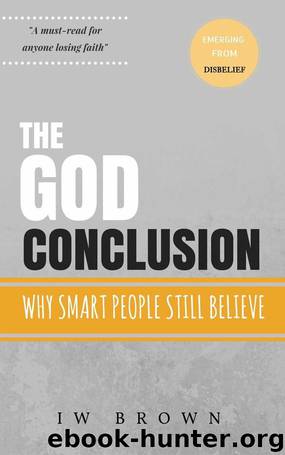The God Conclusion: Why Smart People Still Believe by IW Brown

Author:IW Brown
Language: eng
Format: mobi, epub, azw3
Publisher: Research Publications, LLC
Published: 2015-09-09T18:30:00+00:00
This list was compiled by Richard Dembski, Ph.D. is his book The Design Revolution: Answering the Toughest Questions about Intelligent Design. In his book Dembski argues both that Darwin’s theory is insufficient to account for the diversity of life, and that it tends to be invoked more often than it should.
Dawkins sees natural selection and evolution in everything from the emergence and universality of religious thought to the development of the universe itself. That is, he suspects that our universe in particular is the product of a cosmic evolution. Ours is just one of many universes which were procreated and which are procreating. That’s right. The most effective universes and those endowed with survival advantages ultimately reproduce others with those same traits.
To most of us, however, Dawkins’ enthusiasm appears to have taken him a bit too far. Remember, this boundless optimism for a scientific theory comes from a man who routinely accuses believers of childlike gullibility and a remarkable eagerness to believe without adequate supporting evidence. Significantly, the scientific method typically demands the observability and repeatability of any proposed theory. Unfortunately, the eons required for evolution to yield meaningful change prevent scientists from observing or repeating it—with one small exception.
Much has been made of an attempt to do just that with thousands of generations of bacteria in a lab at Michigan State University. Dr. Richard Linski and his colleagues have been monitoring the life cycles of several strains of bacteria since 1988. So far they have observed more than 60,000 generations of bacteria and carefully studied the results as they relate to natural selection and evolution. That is an average of one new generation about every four hours, making bacteria the best possible candidate for this kind of controlled observation. Linski does report trends toward greater reproductive speed and efficiency; greater fecundity. So what bacteria seems to do best, reproduce, continues to improve. However, critics are quick to counter that no evidence of increased information is to be found in the resulting DNA. That is, 60,000 generations have served to improve viability of bacteria—something widely known about bacteria, including by moms everywhere, long before the experiment began. But they have not served to add information or features in a way which could conceivably lead toward a new life form (51).
In fact we might even say that what has been observed in this experiment is a life form becoming more of what it is, not less. That is, it seems that these bacteria have strengthened and amplified the features which make them bacteria! As I have confessed repeatedly, I am but a layman. But it seems to me that these results are quite the opposite of what Darwinists would have expected—some say what Darwinists would have hoped for. Yet somehow even these counterintuitive results are still presented as evidence for the sufficiency of evolution by natural selection. Incidentally, I am not opposed in any way to the possibility that speciation, meaning evolution by natural selection was and is the primary cause of the proliferation of species, is a valid principle.
Download
The God Conclusion: Why Smart People Still Believe by IW Brown.epub
The God Conclusion: Why Smart People Still Believe by IW Brown.azw3
This site does not store any files on its server. We only index and link to content provided by other sites. Please contact the content providers to delete copyright contents if any and email us, we'll remove relevant links or contents immediately.
From Bacteria to Bach and Back by Daniel C. Dennett(2449)
The God delusion by Richard Dawkins(2266)
Boy Erased by Garrard Conley(1699)
THE SELFISH GENE by Richard Dawkins(1583)
The Falls by Unknown(1488)
Christopher Hitchens by The Portable Atheist: Essential Readings for the Nonbeliever(1286)
THE GOD DELUSION by Richard Dawkins(1284)
God Is Not Great by Christopher Hitchens(1283)
the god delusion by richard dawkins(1277)
Outgrowing God by Dawkins Richard(1273)
Drunk with Blood: God's Killings in the Bible by Steve Wells(1258)
Triumvirate of Rationalism: Thomas Paine, Thomas Jefferson, and George Orwell by Christopher Hitchens(1253)
About the Holy Bible by Robert G. Ingersoll(1234)
The Rage Against God by Peter Hitchens(1230)
Atheism: A Very Short Introduction by Julian Baggini(1192)
The Atheist Muslim by Ali A. Rizvi(1183)
Why I Am Not a Christian and Other Essays by Bertrand Russell(1144)
Battling the Gods by Tim Whitmarsh(1130)
Emancipation of a Black Atheist by D. K. Evans(1122)
